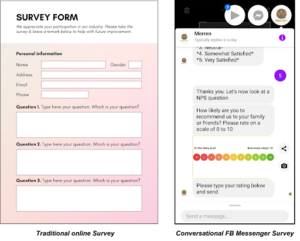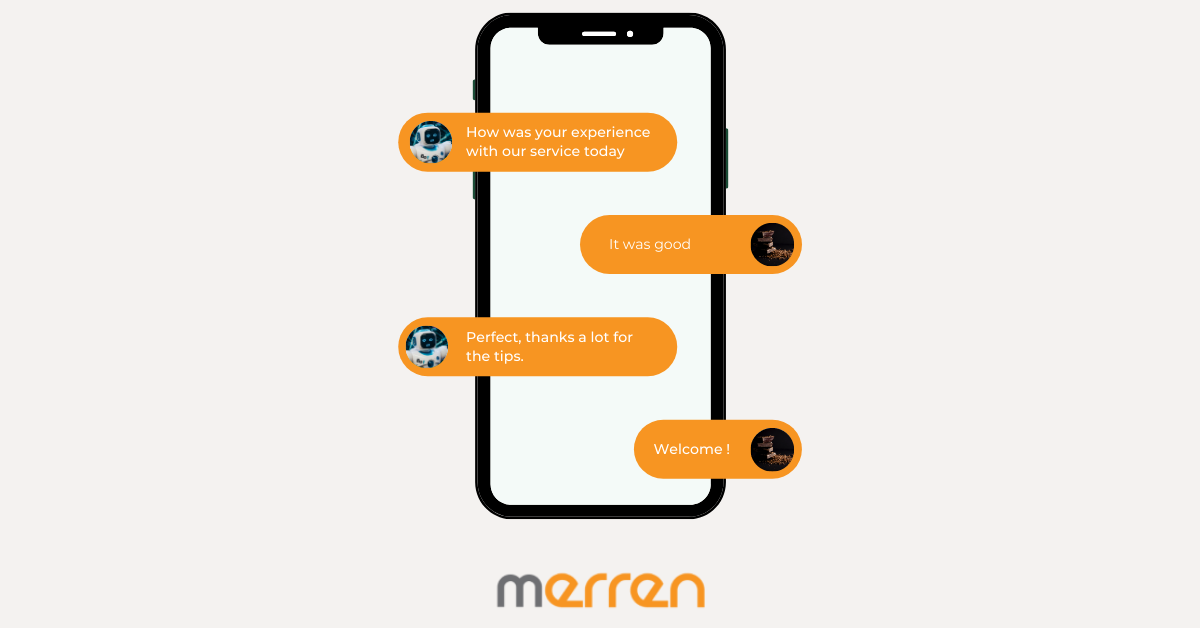As customer feedback becomes increasingly important for businesses of all sizes, conversational surveys have emerged as an effective way to gather response quickly, accurately, and in real-time. In this blog, we’ll take a closer look at what conversational surveys are and how they differ from traditional survey methods.
What Are Conversational Surveys?
Conversational surveys are a type of survey that uses conversational format to engage customers and collect feedback in a natural, informal way. These surveys can be delivered through a variety of channels, such as messaging apps like WhatsApp, Facebook or Instagram Messenger, conversational chatbots, and dynamic emails.
Unlike traditional survey methods, which typically use static questionnaires or forms, conversational feedback use a more interactive approach that allows for more personalized responses. By using a more natural format, conversational surveys can help businesses collect feedback that is more accurate, detailed, and up-to-date.
How Do Conversational Surveys Differ From Traditional Survey Methods?

There are several key differences between conversational surveys and traditional online survey methods:
- Delivery: Conversational surveys can be delivered through a variety of channels, whereas traditional surveys are typically delivered through email, phone, or postal mail.
- Format: Conversational surveys use natural language and and can be more interactive than traditional surveys, which typically use static questionnaires or forms. The survey happens in an interview style where the next question is delivered only when the previous question has been answered.
- Response Rate: Conversational surveys often have a higher response rate than traditional surveys because they are more engaging and feel less like a chore to complete.
- Real-time Feedback: Conversational surveys provide real-time feedback, allowing businesses to address customer concerns quickly and effectively. This leads to richer insights and better customer service
Conversational surveys are a more engaging and effective way to collect customer feedback than traditional survey methods.
In the next section, we’ll take a closer look at how conversational surveys can help businesses gather more accurate and up-to-date customer feedback.
How Can Conversational Surveys Help Businesses Gather More Accurate and Up-to-Date Customer Feedback?
Conversational surveys offer several advantages over traditional survey methods when it comes to gathering accurate and up-to-date customer feedback. In this section, we’ll take a closer look at how conversational surveys can help businesses gather more accurate and up-to-date customer feedback.
Personalization and Contextualization
Conversational surveys allow businesses to personalize questions and responses based on a customer’s previous interactions with the business. This helps to ensure that the questions are relevant and contextualized, which can lead to more accurate and meaningful feedback.
Improved Response Rates
Traditional survey suffer from increasingly poor response rates. Conversational surveys often have higher response rates than traditional survey methods because they are more engaging and feel less like a chore to complete. By using conversational language and allowing customers to provide response in a natural and informal way, businesses can encourage more customers to participate in the survey.
Real-Time Feedback
Conversational surveys provide real-time feedback, which can help businesses address customer concerns quickly and effectively. By collecting feedback in real-time, businesses can identify and respond to issues as they arise, rather than waiting for the survey results to come in.
Increased Customer Satisfaction
By using conversational surveys to gather feedback, businesses can show customers that they care about their opinions and are committed to improving their experiences. This can lead to increased customer satisfaction and loyalty, which can have a positive impact on revenue and growth.
Conversational surveys offer several advantages over traditional survey methods when it comes to gathering accurate and up-to-date customer response.
In the next section, we’ll take a closer look at how businesses can use the data collected from conversational surveys to improve customer experiences and increase revenue.
How Can Businesses Use the Data Collected from Conversational Surveys to Improve Customer Experiences and Increase Revenue?
![]()
![]()

Conversational surveys can provide businesses with valuable insights into their customers’ needs and preferences. In this section, we’ll take a closer look at how businesses can use the data collected from conversational surveys to improve customer experiences and increase revenue.
Identify Customer Needs and Preferences
Conversational surveys can help businesses identify customer needs and preferences by providing insights into what customers are looking for in a product or service. This can help businesses tailor their offerings to better meet customer needs and improve the overall customer experience.
Address Customer Concerns and Issues
By collecting feedback in real-time, conversational surveys can help businesses identify and address customer concerns and issues quickly and effectively. This can help to prevent negative reviews or complaints and improve overall customer satisfaction.
Improve Products and Services
Conversational surveys can provide businesses with insights into what customers like and dislike about their products and services. This information can be used to improve existing products and services or to develop new offerings that better meet customer needs.
Increase Revenue and Growth
By improving customer experiences and addressing customer concerns, businesses can increase customer loyalty and retention, leading to increased revenue and growth. Additionally, by developing new products and services based on customer feedback, businesses can tap into new markets and revenue streams.
Conversational surveys is an ideal market research tool and can provide businesses with valuable insights into their customers’ needs and preferences, which can be used to improve the customer experience, address customer concerns, and increase revenue and growth. In the next section, we’ll take a closer look at the benefits of using messaging apps like WhatsApp, Facebook Messenger, or Instagram Messenger for conversational surveys.
What Are the Benefits of Using Messaging Apps or SMS for Conversational Surveys?
Messaging apps like WhatsApp, Facebook Messenger, and Instagram Messenger and SMS are increasingly popular channels for businesses to communicate with their customers. In this section, we’ll take a closer look at the benefits of using messaging apps for conversational surveys.
Convenience & In-moment Responses
Messaging apps are convenient for customers to use since they can be accessed from their mobile phone at any time. This makes it easy for customers to respond to surveys on the go, without having to be tied to a computer. This makes sense because there are 5.34 billion unique mobile phone users today. The nature of the messaging app survey (such as the use of notifications) will mean that you get real-time responses to your questions. This ability to capture in-moment responses makes conversational surveys extremely powerful
Accessibility
Messaging apps are accessible to a wide range of customers, regardless of their location . This makes it easier for businesses to reach a larger and more diverse audience with their surveys.
Personalization
Messaging apps allow businesses to personalize their surveys based on a customer’s previous interactions with the business. This can help to ensure that the questions are relevant and contextualized, which can lead to more accurate and meaningful feedback.
Engagement
Messaging apps are more engaging than traditional survey methods since they allow businesses to use conversational language and provide a more interactive and personalized experience for customers.
Automation
Messaging apps can be integrated with the CRM, which can automate the survey process and provide customers with immediate responses to their feedback. This can help to improve response rates and make the survey process more efficient.
Using messaging apps for conversational surveys can provide businesses with a convenient, accessible, personalized, engaging, and automated way to gather customer feedback. In the next section, we’ll take a closer look at how businesses can use dynamic emails for conversational surveys and the benefits of this approach.
Flexibility
Messaging app-based surveys offer a high level of flexibility compared to traditional survey methods. One major advantage is the ability to use different question types, such as multiple choice, open-ended, and rating scales. This allows businesses to collect a wide range of feedback from their customers and gain valuable insights into their preferences and experiences.
In addition to text-based responses, messaging app-based surveys also allow for the collection of media such as photos and videos. This can be particularly useful for businesses in industries such as travel and hospitality, where customers may want to provide visual feedback on their experiences. Furthermore, the ability to collect documents such as receipts or invoices can help businesses address specific customer concerns or issues.
Another key advantage of messaging app-based surveys is the ability to support multiple languages. With messaging apps being used by people from all over the world, businesses can use this channel to reach a wider range of customers and collect feedback in their preferred language. This can help businesses gain a better understanding of the needs and preferences of their diverse customer base.
How Can Businesses Use Dynamic Emails for Conversational Surveys?

Dynamic emails are a type of email that allows businesses to include interactive and personalized content in their emails. In this section, we’ll take a closer look at how businesses can use dynamic emails for conversational surveys and the benefits of this approach.
Personalization
Dynamic emails allow businesses to personalize their surveys based on a customer’s previous interactions with the business. This can help to ensure that the questions are relevant and contextualized, which can lead to more accurate and meaningful feedback.
Interactive Content
Dynamic emails allow businesses to include interactive content such as buttons, sliders, and drop-down menus in their surveys. This can make the survey experience more engaging for customers and lead to higher response rates. Additionally, businesses can use dynamic emails to provide customers with visual aids such as images, videos or GIFs to help them better understand the questions being asked.

Multi-Device Compatibility
Dynamic emails are compatible with multiple devices and email clients, which can help to ensure that the survey is accessible to a wider audience. Moreover, dynamic emails can also be used to follow up with customers who have already provided feedback. Businesses can use this opportunity
to thank the customer for their feedback, respond to any concerns or issues raised, and provide updates on the actions taken to address those concerns. This can help businesses to build stronger relationships with their customers by demonstrating that they value customer feedback and are committed to improving the customer experience.
Automation
Dynamic emails can be integrated with automation tools, which can help businesses to send personalized surveys to customers at the right time and automate the survey process. This can make the survey process more efficient and improve response rates. Moreover, by integrating this process with the CRM, not only can the customer feedback process be completely automated, the closing the loop with the customer can be faster and more meaningful.
Real-Time Feedback
Dynamic emails can provide businesses with real-time feedback, which can help to identify customer concerns and issues quickly and effectively. This can help to prevent negative reviews or complaints and improve overall customer satisfaction.
Using dynamic emails for conversational surveys can provide businesses with a personalized, interactive, multi-device compatible, automated, and real-time way to gather customer feedback. In the next section, we’ll take a closer look at how conversational chatbots work for collecting customer feedback and their advantages over static survey forms.
How Do Conversational Chatbots Work for Collecting Customer Feedback?
Conversational chatbots are a type of artificial intelligence that can simulate human conversation in a natural way. In this section, we’ll take a closer look at how conversational chatbots work for collecting customer feedback and their advantages over static survey forms.
Personalization
Conversational chatbots can use customer data and previous interactions with the business to personalize the survey questions and responses. This can help to ensure that the questions are relevant and contextualized, which can lead to more accurate and meaningful feedback.
Automation
Conversational chatbots can automate the survey process and provide customers with immediate responses to their feedback. This can help to improve response rates and make the survey process more efficient. Moreover, integrating them with the CRM can help improve actionability and shorten turnaround time of response.
Scalability
Conversational chatbots can handle a large volume of customer feedback simultaneously, which can make them a scalable solution for businesses that need to collect feedback from a large customer base.
Analytics
Conversational chatbots can provide businesses with real-time analytics on customer feedback, which can help to identify trends and issues quickly and effectively. This can help businesses to improve customer satisfaction and loyalty.
Conversational chatbots can provide businesses with a natural, personalized, automated, scalable, and analytics-driven way to collect customer feedback. In the next section, we’ll take a closer look at some examples of successful conversational surveys and what can be learned from their design and implementation.
Examples of Successful Conversational Surveys and What Can Be Learned from Them
In this section, we’ll take a closer look at some examples of successful conversational surveys and what businesses can learn from their design and implementation.
Example 1: Marriott Hotels
Marriott Hotels used Facebook Messenger to create a conversational survey that asked customers about their hotel experiences. The survey included personalized questions based on the customer’s previous interactions with Marriott, and provided customers with real-time responses to their feedback. Marriott reported a 41% response rate for the survey, which helped the company to identify areas for improvement and increase customer satisfaction.
Key takeaway: Personalization and real-time feedback can lead to higher response rates and more accurate feedback.
Example 2: H&M
H&M used a conversational survey to collect feedback from customers about their online shopping experience. The survey was designed as a chatbot that provided customers with a personalized shopping assistant, while also collecting feedback on the customer’s experience. H&M reported a 70% completion rate for the survey, which helped the company to improve its online shopping experience and increase sales.
Key takeaway: Incorporating the survey into the customer’s overall experience can lead to higher completion rates and more accurate feedback.
Example 3: Domino’s Pizza
Domino’s Pizza used a conversational survey to collect feedback from customers about their delivery experience. The survey was designed as a chatbot that provided customers with real-time updates on their pizza delivery, while also collecting feedback on the customer’s experience. Domino’s reported a 50% response rate for the survey, which helped the company to identify areas for improvement and increase customer satisfaction.
Key takeaway: Incorporating the survey into the customer’s overall experience and providing real-time updates can lead to higher response rates and more accurate feedback.
These examples show that conversational surveys can be successful when they are personalized, integrated into the customer’s experience, and provide real-time feedback. In the next section, we’ll take a closer look at some best practices for creating conversational survey questions to ensure high-quality responses.
Best Practices for Creating Conversational Survey Questions
In this section, we’ll cover some best practices for creating conversational survey questions that can lead to high-quality responses.
1. Keep questions short and simple
Conversational surveys should be designed with the understanding that customers are often busy and may not have the time or patience to answer long or complex questions. Keeping questions short and simple can help to increase response rates and ensure that the feedback collected is accurate.
2. Use open-ended questions
Open-ended questions are a great way to encourage customers to provide detailed feedback that can provide valuable insights into their experiences. Open-ended questions also allow customers to express their opinions and feelings in their own words, which can provide a more nuanced understanding of their experiences.
3. Avoid leading questions
Leading questions are questions that are designed to elicit a specific response or bias the customer’s feedback in a certain direction. Avoiding leading questions can help to ensure that the feedback collected is unbiased and accurate.
4. Use branching logic
Branching logic is a technique that allows for questions to be skipped or hidden based on the customer’s previous responses. This can help to ensure that customers are only asked relevant questions, which can increase response rates and ensure that the feedback collected is accurate.
5. Provide context
Providing context for the questions being asked can help to ensure that customers understand what they are being asked and why their feedback is important. Providing context can also help to increase response rates and ensure that the feedback collected is accurate.
6. Test the survey
Testing the survey with a small group of customers can help to identify any issues with the survey design or question wording. Testing can also help to ensure that the survey is easy to use and understand, which can increase response rates and ensure that the feedback collected is accurate.
Creating conversational survey questions that are short, simple, open-ended, unbiased, and provide context can help to ensure that the feedback collected is accurate and valuable. In the next section, we’ll cover some common mistakes to avoid when implementing conversational surveys.
Most survey platforms offer templates that can be used as a starting point for creating a good survey. Most times however, these templates become restrictive and unusable. Merren has an AI survey builder feature that allows users to build a perfect survey in a few clicks.
What Questions Should I Ask An A Customer Survey?

To create a good customer survey, it is important to ask questions that provide valuable insights into the customer experience. Here are some questions that you may want to consider:
- How likely are you to recommend our product/service to others?
- How satisfied are you with our product/service?
- How easy was it to use our product/service?
- Did our product/service meet your expectations?
- How responsive were our customer support representatives?
- How would you rate the overall value of our product/service?
- How frequently do you use our product/service?
- What did you like best about our product/service?
- What did you like least about our product/service?
- Is there anything we can do to improve our product/service?
It’s also important to ask open-ended questions that allow customers to share their thoughts and feelings in their own words. Some examples of open-ended questions are:
- What are some specific things we could do to improve your experience with our product/service?
- Can you share a recent experience you had with our product/service?
- Is there anything else you would like to share with us about your experience with our product/service?
Additionally, you may want to ask demographic questions to better understand the characteristics of your customers, such as age, gender, income, and location. However, be sure to only ask for information that is relevant to your business and avoid asking for sensitive information that may make customers uncomfortable. To know more, read our blog on how to create a good customer survey
Common Mistakes to Avoid When Implementing Conversational Surveys
In this section, we’ll cover some common mistakes to avoid when implementing conversational surveys to ensure that the feedback collected is accurate and valuable.
1. Overwhelming customers with too many questions
Conversational surveys should be designed with the understanding that customers may not have the time or patience to answer too many questions. Overwhelming customers with too many questions can lead to low response rates and inaccurate or incomplete feedback.
2. Failing to personalize the survey
Personalizing the survey by addressing the customer by name or referencing their previous interactions with the business can help to increase response rates and ensure that the feedback collected is accurate. Failing to personalize the survey can make customers feel like they are just another number, which can lead to low response rates and inaccurate feedback.
3. Neglecting to follow up with customers
Following up with customers after they have completed the survey can help to show that their feedback is valued and that the business is committed to improving their experiences. Neglecting to follow up with customers can make them feel like their feedback is not important, which can lead to low response rates in future surveys.
4. Asking leading questions
Asking leading questions can bias the customer’s feedback in a certain direction and lead to inaccurate or incomplete feedback. Avoiding leading questions and providing customers with the opportunity to express their opinions and feelings in their own words can lead to more accurate and valuable feedback.
5. Failing to analyze and act on the feedback
Collecting feedback is only half of the process. Failing to analyze and act on the feedback collected can make customers feel like their feedback is not valued, which can lead to low response rates in future surveys. Analyzing and acting on the feedback can help to improve customer experiences and increase customer loyalty.
6. Using inappropriate language or tone
Using inappropriate language or tone in the survey can make customers feel uncomfortable or offended, which can lead to low response rates and inaccurate or incomplete feedback. Using a friendly and professional tone and avoiding offensive or inappropriate language can help to increase response rates and ensure that the feedback collected is accurate and valuable.
Avoiding common mistakes such as overwhelming customers with too many questions, failing to personalize the survey, neglecting to follow up with customers, asking leading questions, failing to analyze and act on the feedback, and using inappropriate language or tone can help to ensure that conversational surveys are effective in collecting accurate and valuable feedback from customers.
Emerging Trends in Conversational Surveys
In this section, we’ll cover some emerging trends in conversational surveys and how they are likely to shape the future of customer feedback collection.
1. Artificial Intelligence (AI) and Machine Learning
AI and machine learning are revolutionizing the way that conversational surveys are designed and implemented. These technologies allow for more personalized and targeted surveys that can be tailored to individual customers based on their past interactions with the business. AI and machine learning can also help to analyze the feedback collected and provide insights that can be used to improve customer experiences and increase revenue.
2. Voice-Activated Surveys
Voice-activated surveys are becoming increasingly popular as more customers use voice assistants such as Amazon’s Alexa or Google Assistant to interact with businesses. Voice-activated surveys can provide a more natural and convenient way for customers to provide feedback, and they can also help to increase response rates.
3. Social Listening
Social listening involves monitoring social media platforms for customer feedback and insights. This approach allows businesses to collect feedback in real-time and respond quickly to customer concerns and issues. Social listening can also help to identify emerging trends and issues that can be addressed before they become major problems.
4. Multi-Channel Surveys
Multi-channel surveys involve using a combination of different channels to collect feedback, such as email, SMS, messaging apps, and social media. This approach allows businesses to reach customers on their preferred channels and can help to increase response rates and improve the accuracy of the feedback collected.
5. Gamification
Gamification involves using game mechanics such as points, badges, and leaderboards to make surveys more engaging and fun for customers. This approach can help to increase response rates and improve the quality of the feedback collected.
6. Predictive Analytics
Predictive analytics involves using data and statistical algorithms to identify patterns and predict future outcomes. This approach can be used to analyze the feedback collected from conversational surveys and provide insights into customer behavior and preferences. Predictive analytics can also help businesses to anticipate future customer needs, improve customer experiences, and keep track of key performance metrics.
These emerging trends are likely to shape the future of customer feedback collection by making surveys more personalized, convenient, and engaging for customers. Businesses that adopt these trends early are likely to gain a competitive advantage by improving customer experiences and increasing customer loyalty.
Conclusion
Conversational surveys are a powerful tool for collecting quick, accurate, and up-to-date customer feedback. By using messaging apps, conversational chatbots, dynamic emails, and other conversational channels, businesses can reach customers where they are and collect feedback in a way that is natural and convenient. By avoiding common mistakes and embracing emerging trends such as AI, voice-activated surveys, and social listening, businesses can improve the accuracy and value of the feedback collected, and ultimately improve customer experiences and increase revenue.





